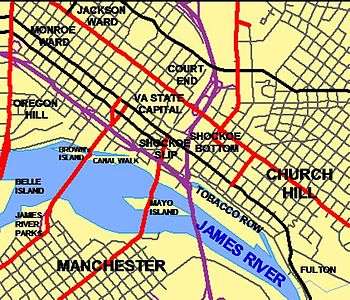Tobacco Row, Richmond
Coordinates: 37°31′46.5″N 77°25′27.4″W / 37.529583°N 77.424278°W Tobacco Row is a collection of tobacco warehouses and cigarette factories in Richmond, Virginia adjacent to the James River and Kanawha Canal near its eastern terminus at the head of navigation of the James River.
History
Beginning in the 18th century, many growers and shippers of Virginia's major cash-crop of tobacco maintained facilities there, as well as directly across the river at Manchester. Substantial multi-story brick buildings were constructed to protect the contents from loss due to fire.
During the American Civil War (1861–1865), Tobacco Row was the site of infamous Libby Prison and nearby Castle Thunder, detention facilities of the Confederate government.
In 1925, WRVA radio, owned by Larus and Brother tobacco company, went on the air, broadcasting from a studio located in a corner of their House of Edgeworth warehouse, with a tower mounted on the roof of the building.
Adaptive Reuse
The area was vacated by the tobacco companies by the late 1980s. Following completion of Richmond's James River Flood Wall in 1995, led by Richmond developer William H. Abeloff, many of the old warehouses of Tobacco Row were modernized and converted into developments of loft apartments, condominiums, offices, and retail space along part of the restored canal system.

One of the warehouses is home to the Virginia Holocaust Museum.
In the mid 2010s, the neighborhood was introduced to the extreme western portion of the Virginia Capital Trail.
See also
References
External links
- Historic Richmond Foundation - Historic Areas: Tobacco Row
- River District News
- River Lofts at Tobacco Row
 |
Church Hill | Libby Hill |  | |
| Shockoe Bottom | |
Fulton Hill | ||
| ||||
| | ||||
| The James River | Rocketts Landing |